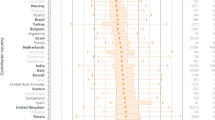Abstract
Background
Specific data is needed to safely expand bariatric surgery and to preserve good surgical outcomes in response to the non-stop increase in obesity prevalence worldwide.
Objective
The aims of this study are to provide an overview of the baseline characteristics, type of surgery, and 30-day postoperative morbidity and mortality in patients undergoing bariatric surgery in Spanish public hospitals, and evaluate changes throughout the 2000–2014 period.
Material and Methods
This is a descriptive study using data from the RICIBA, a computerized multicenter and multidisciplinary registry created by the Obesity Group of the Endocrinology and Nutrition Spanish Society. Three periods according to the date of surgery were created: January 2000 to December 2004 (G1), January 2005 to December 2009 (G2), and January 2010 to December 2014 (G3).
Results
Data from 3843 patients were available (44.8 ± 10.5 years, a 3:1 female-to-male ratio, 46.9 ± 8.2 kg/m2). Throughout the 15-year period assessed, candidate patients for bariatric surgery were progressively older and less obese, with an increase in associated comorbidities and in the prevalence of men. The global trend also showed a progressive decrease in Roux-en-Y gastric bypass, the most performed bariatric procedure (75.1 % in G1, 69.3 % in G2, and 42.6 % in G3; p < 0.001), associated with a parallel increase in sleeve gastrectomy (0.8 % in G1, 18.1 % in G2, and 39.6 % in G3; p < 0.001). An overall mortality rate of 0.3 % was reported.
Conclusions
Data from Spain is similar to data observed worldwide. Information recorded in the National Registries like RICIBA is necessary in order to safely expand bariatric surgery in response to increasing demand.

Similar content being viewed by others
References
Finucane MM, Stevens GA, Cowan MJ, et al. National, regional, and global trends in body-mass index since 1980: systematic analysis of health examination surveys and epidemiological studies with 960 country-years and 9.1 million participants. Lancet. 2011;377:557–67.
Berghöfer A, Pischon T, Reinhold T, et al. Obesity prevalence from a European perspective: a systematic review. BMC Public Health. 2008;8:200.
Gutiérrez-Fisac JL, Guallar-Castillón P, León-Muñoz LM, et al. Prevalence of general and abdominal obesity in the adult population of Spain, 2008–2010: the ENRICA study. Obes Rev. 2012;13:388–92.
Neira M, de Onis M. The Spanish strategy for nutrition, physical activity and the prevention of obesity. Br J Nutr. 2006;96 Suppl 1:S8–11.
Buchwald H, Oien DM. Metabolic/bariatric surgery worldwide 2008. Obes Surg. 2009;19:1605–11.
Courcoulas AP, Christian NJ, Belle SH, et al. Weight change and health outcomes at 3 years after bariatric surgery among individuals with severe obesity. JAMA. 2013;310:2416–25.
Buchwald H, Avidor Y, Braunwald E, et al. Bariatric surgery: a systematic review and meta-analysis. JAMA. 2004;92:1724–37.
Ramos-Leví AM, Rubio Herrera MA. Metabolic surgery: quo vadis? Endocrinol Nutr. 2014;61:35–46.
Buchwald H, Oien DM. Metabolic/bariatric surgery worldwide 2011. Obes Surg. 2013;23:427–36.
Angrisani L. Santonicola a., Iovino P, Formisano G, Buchwald H, Scopinaro N. Bariatric Surgery Worldwide 2013. Obes Surg. 2015;25:1822–32.
Fort JM, Vilallonga R, Lecube A, et al. Bariatric surgery outcomes in a European Centre of Excellence (CoE). Obes Surg. 2013;23:1324–32.
Gastrointestinal surgery for severe obesity. National Institutes of Health Conference Statement. Am J Clin Nutr. 1992; 55: 615S-9S.
Lecube A, Monereo S. RICIBA (Computerized registry of bariatric surgery), what do we know about bariatric surgery in Spain? Endocrinol Nutr. 2011;58:323–4.
American Diabetes Association. Diagnosis and classification of diabetes mellitus. Diabetes Care. 2005;28:S37–42.
Rubino F. From bariatric to metabolic surgery: definition of a new discipline and implications for clinical practice. Curr Atheroscler Rep. 2013;15:369.
Rubino F, Shukla A, Pomp A, et al. Bariatric, metabolic, and diabetes surgery: what’s in a name? Ann Surg. 2014;259:117–22.
Vidal P, Ramón JM, Goday A, et al. Laparoscopic gastric bypass versus laparoscopic sleeve gastrectomy as a definitive surgical procedure for morbid obesity. Mid-term results. Obes Surg. 2013;23:292–9.
Peterli R, Borbély Y, Kern B, et al. Early results of the Swiss Multicentre Bypass or Sleeve Study (SM-BOSS): a prospective randomized trial comparing laparoscopic sleeve gastrectomy and Roux-en-Y gastric bypass. Ann Surg. 2013;258:690–4.
Puzziferri N, Austrheim-Smith IT, Wolfe BM, et al. Three-year follow-up of a prospective randomized trial comparing laparoscopic versus open gastric bypass. Ann Surg. 2006;243:181–8.
Caiazzo R, Pattou F. Adjustable gastric banding, sleeve gastrectomy or gastric bypass. Can evidence-based medicine help us to choose? J Visc Surg. 2013;150:85–95.
Chang SH, Stoll CR, Song J, et al. The effectiveness and risks of bariatric surgery: an updated systematic review and meta-analysis, 2003–2012. JAMA Surg. 2014;149:275–87.
Reoch J, Mottillo S, Shimony A, et al. Safety of laparoscopic vs open bariatric surgery. Arch Surg. 2013;146:1314–22.
Acknowledgments
Cicle Serveis Informàtics developed the website of RICIBA. The RICIBA is a property of the Spanish Society of Endocrinology and Nutrition (SEEN).
Author information
Authors and Affiliations
Corresponding author
Ethics declarations
Conflict of Interest
The authors declare that they have no competing interest.
Ethical Approval
All procedures performed in studies involving human participants were in accordance with the ethical standards of the institutional and/or national research committee and with the 1964 Helsinki Declaration and its later amendments or comparable ethical standards.
Grant Support
Nestlé España, S.A. is the sole sponsor and provides unrestricted technical support to RICIBA.
Additional information
Albert Lecube and Ana de Hollanda contributed equally to this work.
Rights and permissions
About this article
Cite this article
Lecube, A., de Hollanda, A., Calañas, A. et al. Trends in Bariatric Surgery in Spain in the Twenty-First Century: Baseline Results and 1-Month Follow Up of the RICIBA, a National Registry. OBES SURG 26, 1836–1842 (2016). https://doi.org/10.1007/s11695-015-2001-3
Published:
Issue Date:
DOI: https://doi.org/10.1007/s11695-015-2001-3




